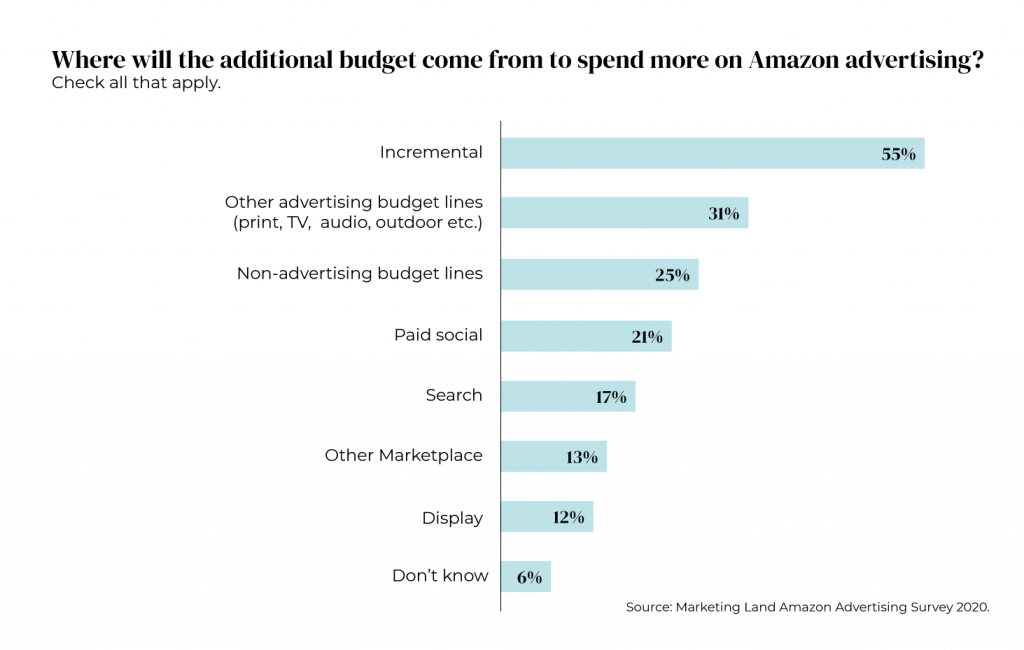
Commerce marketing - Why e-commerce platforms are set to become the next big destination for ad investments
What is commerce marketing or commerce advertising?
Commerce marketing or commerce advertising is a term that refers to advertising products or services on e-commerce platforms such as Amazon, Alibaba, or Zalando. Here are a couple of examples of commerce advertising:
Amazon offers retailers the chance to display their products within product searches, similar to Google’s search ads.

The growth of commerce marketing has been brewing for a couple of years and is set to burst in 2021 as e-commerce continues to grow and companies are in need of discovering more ways to boost online sales and not just through their online stores. COVID-19 has only intensified the growth of e-commerce and there is a perfect storm of changes happening that are creating the ideal conditions for e-commerce platforms to become a big destination for advertiser’s wallets globally and also here in Finland.
This article explains the trends that are driving the change for e-commerce platforms to become a big destination for ad investments in the coming years and what this means for advertisers and e-commerce platforms.
E-commerce environment combined with vast purchase and behavioral data creates the basis for excellent advertising productization
As e-commerce continues to grow, the biggest online retailers attract a huge number of potential buyers. A recent study from the US showed that over half of online shoppers begin their shopping journey with an e-commerce platform, such as Amazon. This audience is very valuable to merchants selling through Amazon, and it has created a new channel for advertisers to promote their products. Amazon has paved the way in turning the online store into a “media” by offering companies the tools and data to target customers and advertise their products on Amazon. Amazon’s ad business grew 40% year-on-year in 2019, to approximately $14 billion. Amazon is by no means the only e-commerce platform that has already created a significant stream of new income from advertising. Walmart recently reported $1B in annual ad sales.
In fact, commerce advertising has become the third-largest online advertising channel behind search and social. Commerce advertising is also growing faster than paid search and social did in their first years.
The reasons for this growth are obvious. Commerce advertising bridges the gap between online demand and traditional retail channels. It offers retailers customers who are ready to buy, rich data to target potential buyers, and a tactical selling channel to many manufacturers and vendors who traditionally may have been concentrating on the top of the funnel marketing activities. Further manufacturers who have not invested in their online store capabilities can boost online sales significantly by utilizing these platforms.
The death of cookies will raise the need for advertisers to target customers in new ways
As cookies are being phased out as the primary means to target advertising for consumers online, it will create challenges for advertisers, publishers, tech providers to find alternative ways to target potential customers. This will lead to more dependency on the biggest tech giants (Facebook, Google, Amazon) and their walled gardens as they can use their own first-party data and are less reliant on cookies. Advertisers are surely on the lookout for new ways to target potential customers as retargeting for example will be heavily impacted by cookie deprecation.
These changes provide a great opportunity for e-commerce platforms to offer data-driven marketers ways to target potential clients. E-commerce platforms have loads of first-party data that can help advertisers target potential customers accurately based on their purchase history and without cookies. On top of that, they provide advertisers with an environment that is very close to the actual purchase moment. The customers who visit online stores are generally in “shopping mode”.

What does this mean?
For advertisers
For consumer goods / FMCG advertisers commerce advertising will create new ways to reach potential clients and boost sales online. Advertising on e-commerce platforms provides advertisers a huge audience of potential ready-to-buy customers with data that covers the whole funnel from an ad delivered to actual purchase. Thus advertisers can get a very clear picture of the return of their marketing investments in these platforms.
However, the increasing dominance of different e-commerce platforms raises the need for brands to rethink their whole e-commerce strategy. For example, what is the role of your brand’s online store when e-commerce platforms can provide the technical capabilities, ready-to-buy target groups, and efficient ways to target? You can read further on this topic in Dagmar’s blog post (in Finnish) here.
For e-commerce platforms
Naturally, building the capabilities to commercialize an e-commerce platform doesn’t happen overnight. It requires:
- Significant traffic to the e-commerce site to be valuable to potential advertisers
- A solid plan to commercialize the e-com with a gradual development road map
- Investments to create an advertising infrastructure
However, commerce marketing presents a completely new source of income for many e-commerce platforms, not only for the biggest global players such as Amazon, Alibaba, or Zalando. Further, it represents a way for e-commerce platforms to deepen their relationships with suppliers and vendors. It will also enhance capabilities to create better customer experiences for the e-commerce platforms and increase sales through personalization.
Furthermore, a survey by Marketing Land suggests that more than half of marketers are going to increase their advertising spend on Amazon and commerce advertising in 2021. Moreover, the majority of the spending on Amazon is incremental or coming from other channels (mainly offline advertising such as print, TV, or radio). These signs indicate that brands are very interested in investing in advertising in this space in the future.

Conclusion
I am sure that in the coming years, we are going to see a lot more e-commerce platforms following the trend, started by the biggest players like Amazon, Walmart, and Zalando, of becoming “medias”. There are some initiatives in this space seen in Finland too, like Zalando’s connected retail. It is interesting to see which Finnish e-commerce player will take the first step in this space and grab the first movers’ advantages.
Interested to talk more about the topic? Send an email to ville.fredrikson@radly.fi or contact him through LinkedIn.
Liked this post? Share it with your friends
Sources:
https://marketingland.com/amazon-advertising-survey-2020-276201
https://nypost.com/2020/10/20/walmarts-ad-arm-reportedly-nears-1-billion-in-annual-sales/
Bank of America: Forrester Analytics: ShawSpring Research; Us Department of Commerce; McKinsey Analysis 2020
Statista; Revenue growth in eCommerce in Finland, November 2020
https://insideretail.com.au/news/majority-of-online-shoppers-compare-brands-to-amazon-201903
Digiday 15.5.2020 sponsored by Keshoo
Warc news 09/2020